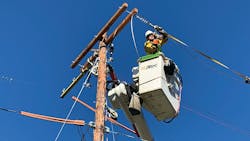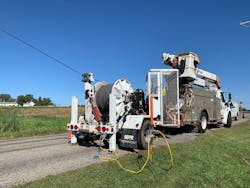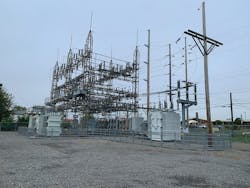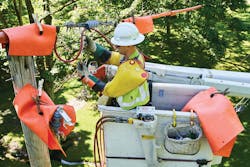Penn Power Hardens System to Boost Reliability
Winter storms have the potential to cause damage to poles, wires and substations, requiring crews to make repairs in difficult conditions. The weight of wet snow and ice can put extra stress on the system as well as on trees and other structures that can impact equipment.
By completing this work ahead of the recent winter season, Penn Power strengthened its electric system and kept the lights on for customers when they depended on it the most to stay warm and comfortable. Each year, Penn Power prepares for winter by conducting inspections and equipment maintenance on weather-sensitive equipment across its service area. Completing inspections and maintenance of equipment during the summer and fall can help enhance system resiliency to keep power flowing to customers when severe winter weather strikes.
The work includes the use of special thermal-imaging cameras to detect hot spots, or weak points, invisible to the naked eye on electrical equipment prone to overheating and malfunctioning as customers crank up their heaters to combat the cold. Substation electricians also inspected batteries used to power relays that sense faults on the network and motors that automatically operate switches to isolate those problems, helping to prevent service interruptions or limit their size and scope.
Replacing Power Lines
Penn Power distributes the work across its entire internal labor force to give equal training and experience to all of its employees. Setting poles is a job the lineworkers perform every day, but stringing thousands of feet of wire at once is a less common project and very time consuming. For such projects, the company oftentimes hires contractor crews to assist in completing the work ahead of schedule. These projects are prime situations for training exposure, and they allow the younger lineworkers to gain experience from the more seasoned employees.
Recently, Penn Power expanded upon its traditional winter readiness work to install about 1,000 new poles and replace more than 184,000-feet of power lines with thicker, durable wire designed to withstand severe winter elements like ice and heavy, wet snow.
This type of wire has been used in the past by each of FirstEnergy’s 10 electric companies, including Penn Power. As energy demand increases each year, the company’s electric system must also be updated to be able to safely provide customers with the power they require.
The more resilient wire offers many different benefits for customers. The larger wire allows for a higher ampacity rating in times of the year when the system is experiencing higher demand, such as the summer and winter months. It also allows the company to use circuit tying capabilities between substations. This is vitally important during peak seasons to help evenly distribute load across the system.
The circuit tying also comes into play during an emergency, such as when a tree falls onto wires or when a car hits a pole. Penn Power will now be able to isolate the faulted section of the system and temporarily pull the needed power from other sources until repairs are completed. This keeps as many customers in power as possible during unexpected outages.
The wire is installed the same way as other conductors, just using larger more heavy-duty equipment and materials to support the increased weights.
Rolling Out Reclosers
In addition, lineworkers installed 72 new automated reclosing devices on three-phase power lines to help restore power to customers within seconds in the event of a power outage and significantly reduce the length of an outage.
Penn Power is already seeing the benefits of the reclosers’ capabilities. Not only do they help in the isolation and restoration of unforeseen power outages, they are providing added benefits to Penn Power’s normal day-to-day operations.
Penn Power also spent the latter part of 2019 installing 120 new automated reclosing devices on single-phase power lines to help limit the frequency and duration of service interruptions. The electrical device works like a circuit breaker in a home with the added benefit of automatically re-energizing a power line within seconds to keep power safely flowing to customers.
To determine the best locations for these devices, utility personnel reviewed outage patterns across Penn Power’s service area and identified outage-prone areas that would benefit from an automated reclosing device. Although most of the work completed in 2019 was concentrated in one particular area within Penn Power’s service territory, the project was a preview of what’s to come over the next five years across the entire Penn Power footprint.
Installing the Devices
Before the reclosers, switching operations on the electric system required a truck to drive out to each location to perform physical switching on the equipment. This can now be performed with the push of a few buttons by an operator inside of the Distribution Control Center (DCC). The installation of new automated reclosing devices and creation of new circuit ties will isolate outages to a smaller number of areas and significantly reduce the length of an outage.
When installing the new reclosers, Penn Power’s lineworkers start by replacing the pole in order to gain height and stability. The conductors are then transferred and dead-ended on each side of the new pole while maintaining a physical break between the two ends of the wire. Next, they install a fiberglass unitized switch arm that contains three separate switches on it. Each switch contains three blades — a source side blade (the direction the power is normally fed from), a load side blade (the wire that is being fed from the source side) and a bypass blade. The bypass blade would be used if the recloser would need to be taken offline and power was still required to flow through that location.
Workers then install the actual recloser, wiring it to the unitized switch arm installed above. The switches are wired onto the conductors previously dead ended on either side of the pole. A communication cable is ran from the recloser to the bottom of the pole where it attaches to an electronic control box. This control box allows an employee to control the recloser from the actual site location or via the SCADA system from the company’s DCC. The final step involves a combined effort of Penn Power’s engineering, substation, overhead lines, communications and DCC groups to test the recloser. Once all tests are passed, it is put into service and released for daily operations.
The company prepares for the installation of these devices by conducting hands-on training classes in line shops for field personnel. By setting up a mock demo of the control boxes, it allows employees to familiarize themselves with the control panel and the different buttons and codes they may come across. Penn Power began slowly by sending out its most experienced lineworkers to install the first recloser. As confidence grew, the company spread out the work across more resources and share the knowledge gained during the initial installations.
Investing in the System
This work was part of Penn Power’s 2016-2020 Long-Term Infrastructure Improvement Plan (LTIIP), approved by the Pennsylvania Public Utility Commission to help enhance electric service for customers. On Aug. 30, 2019, FirstEnergy’s four Pennsylvania utilities filed the proposed 2020-2024 LTIIP with the Pennsylvania Public Utility Commission outlining investments of $572 million over the next four years to accelerate infrastructure improvements and enhance service reliability for more than 2 million customers in the state. The 2020-2024 plan was approved in January. Under this plan, Penn Power is slated to make $72 million in investments to enhance electric service reliability for its more than 160,000 customers in western Pennsylvania.
These investments build on earlier improvement plans with targeted projects designed to reduce the frequency of electric service interruptions for customers and shorten the duration of outages when they do occur. Major initiatives will include replacing older infrastructure with new poles, overhead lines, underground cables, substation equipment, network vaults and manholes; reconfiguring circuits to minimize customers impacted by service interruptions and installing more advanced “smart” devices that can detect and isolate problems to help quickly restore power to impacted customers.
Another major reliability project Penn Power completed in 2019 is the installation of new interior fencing in substations to help deter climbing animals and protect against electrical equipment interference that can cause power outages. The fencing — installed inside of a substation around the perimeter of the equipment — keeps the animals out of harm’s way and the electricity safely flowing to customers. The company plans to install additional animal deterrent substation fencing at other substations over the next five years.
Climbing animals present one of the greatest threats to substation operation and electric service reliability. A single substation outage can cost thousands of dollars in equipment damage and hundreds of man hours to repair as well as causing extended outages for customers served by that circuit. The special fencing was an economical solution to prevent these types of service disruptions in the future.
Unlike other types of animal traps and deterrents, this special fencing completely prevents climbing animals from accessing the substation equipment and discourages them from trying again. Many climbing animals, like squirrels, have a highly developed memory that enables them to remember locations for food, warmth and shelter. With one brief contact with a fence panel, animals learn that a substation is not a welcoming location to visit and typically avoid protected substations in the future. This fencing has proven to be successful for Penn Power’s sister utility in Maryland, which has seen a sharp decline in substation outages due to animals.
Through these proactive measures, FirstEnergy is able to protect its system not only in the winter, but also year-round to minimize outages and improve reliability.
About the Author
Jeff Doran
Jeff Doran is the operations manager at Penn Power.
Lauren Siburkis
Communications
Lauren Siburkis is the external communications representative at FirstEnergy.






